A Secure and Fast Image Encryption Scheme Based on Double Chaotic S-Boxes
Abstract
:1. Introduction
2. The Proposed New Chaotic System
2.1. Sine Chaotic Map
2.2. Tent Chaotic Map
2.3. The Sine-Tent System
3. An Efficient New Method for Generating S-Boxes
4. The Proposed S-Box based Encryption Scheme
4.1. Cryptanalysis of an S-Box Based Encryption Algorithm
| Algorithm 1 The algorithm pseudo code of function q = sub_byte[S, p]. | |
| Input: | S = [s(j, k)], p; (j = 1, 2,…, 16, k = 1, 2, …, 16.) |
| Output: | q= sub_byte[S, p]; |
| 1: | Convert p to a binary number (b8b7…b2b1)2; |
| 2: | Let j = (b8b7b6b5)2 = 8 × b8 + 4 × b7 + 2 × b6 + 1 × b5; k = (b4b3b2b1)2 = 8 × b4 + 4 × b3 + 2 × b2 + 1 × b1; |
| 3: | Let j = j + 1; k = k + 1; |
| 4: | Let q = s(j, k); |
| Algorithm 2 The simplest attacking algorithm pseudo code. | |
| 1: | n = 0; |
| 2: | while (n < 256) do |
| 3: | Choose the n-th plain image Pn = [n, n, …, n]; |
| 4: | Get its corresponding cipher image Cn = [cn(1), cn(2), …, cn(L)] by using the encryption machine of Figure 4; |
| 5: | for i =1, 2, …, L, do |
| if c(i) = = cn(i), then we can get p(i) = n; | |
| 6: | end for |
| 7: | n = n + 1; |
| 8: | end while |
4.2. The Novel Double S-Boxes Based Image Encryption Algorithm
5. Experimental Results and Security Analyses
5.1. Experimental Results
5.2. Key Space Analyses
5.3. Statistical Analysis
5.3.1. Histogram Analysis
5.3.2. Correlation Analysis
5.3.3. Information Entropy Analysis
5.3.4. Sensitivity Analysis
5.4. Analysis of Anti-Attack Performance
5.4.1. Classical Types of Attacks
5.4.2. Analysis of Robustness against Noise and Occlusion
5.5. Analysis of Speed
6. Conclusions
Author Contributions
Funding
Acknowledgments
Conflicts of Interest
References
- Wang, J.; Ding, Q. Dynamic rounds chaotic block cipher based on keyword abstract extraction. Entropy 2018, 20, 693. [Google Scholar] [CrossRef]
- Abdallah, E.E.; Ben Hamza, A.; Bhattacharya, P. Mpeg video watermarking using tensor singular value decomposition. In Lecture Notes in Computer Science, Proceedings of the Image Analysis and Recognition (ICIAR 2007), Montreal, QC, Canada, 5–7 July 2017; Kamel, M., Campilho, A., Eds.; Springer: Berlin/Heidelberg, Germany, 2007; Volume 4633, pp. 772–783. [Google Scholar]
- Abdallah, E.E.; Ben Hamza, A.; Bhattacharya, P. Video watermarking using wavelet transform and tensor algebra. Signal Image Video Process. 2009, 4, 233–245. [Google Scholar] [CrossRef]
- Zhang, S.; Li, X.; Tan, Z.; Peng, T.; Wang, G. A caching and spatial k-anonymity driven privacy enhancement scheme in continuous location-based services. Future Gener. Comput. Syst. 2019, 94, 40–50. [Google Scholar] [CrossRef]
- Zhang, S.; Wang, G.; Bhuiyan, M.Z.A.; Liu, Q. A dual privacy preserving scheme in continuous location-based services. IEEE Internet Things J. 2018, 5, 4191–4200. [Google Scholar] [CrossRef]
- Wang, X.; Pham, V.-T.; Jafari, S.; Volos, C.; Munoz-Pacheco, J.M.; Tlelo-Cuautle, E. A new chaotic system with stable equilibrium: From theoretical model to circuit implementation. IEEE Access 2017, 5, 8851–8858. [Google Scholar] [CrossRef]
- Zhou, Y.; Bao, L.; Chen, C.L.P. A new 1D chaotic system for image encryption. Signal Process. 2014, 97, 172–182. [Google Scholar] [CrossRef]
- Chen, E.; Min, L.; Chen, G. Discrete chaotic systems with one-line equilibria and their application to image encryption. Int. J. Bifurc. Chaos 2017, 27, 1750046. [Google Scholar] [CrossRef]
- Zhu, S.; Zhu, C.; Cui, H.; Wang, W. A class of quadratic polynomial chaotic maps and its application in cryptography. IEEE Access 2019, 7, 34141–34152. [Google Scholar] [CrossRef]
- Sahari, M.L.; Boukemara, I. A pseudo-random numbers generator based on a novel 3d chaotic map with an application to color image encryption. Nonlinear Dyn. 2018, 94, 723–744. [Google Scholar] [CrossRef]
- Murillo-Escobar, M.A.; Cruz-Hernandez, C.; Cardoza-Avendano, L.; Mendez-Ramirez, R. A novel pseudorandom number generator based on pseudorandomly enhanced logistic map. Nonlinear Dyn. 2017, 87, 407–425. [Google Scholar] [CrossRef]
- Islam, F.u.; Liu, G. Designing s-box based on 4D-4wing hyperchaotic system. 3D Res. 2017, 8, 9. [Google Scholar] [CrossRef]
- Alvarez, G.; Li, S. Some basic cryptographic requirements for chaos-based cryptosystems. Int. J. Bifurc. Chaos 2006, 16, 2129–2151. [Google Scholar] [CrossRef]
- Li, C.; Lin, D.; Feng, B.; Lu, J.; Hao, F. Cryptanalysis of a chaotic image encryption algorithm based on information entropy. IEEE Access 2018, 6, 75834–75842. [Google Scholar] [CrossRef]
- Zhu, C.; Wang, G.; Sun, K. Improved cryptanalysis and enhancements of an image encryption scheme using combined 1d chaotic maps. Entropy 2018, 20, 843. [Google Scholar] [CrossRef]
- Zhu, C.; Sun, K. Cryptanalyzing and improving a novel color image encryption algorithm using rt-enhanced chaotic tent maps. IEEE Access 2018, 6, 18759–18770. [Google Scholar] [CrossRef]
- Fridrich, J. Symmetric ciphers based on two-dimensional chaotic maps. Int. J. Bifurc. Chaos 1998, 8, 1259–1284. [Google Scholar] [CrossRef]
- Zhang, X.; Fan, X.; Wang, J.; Zhao, Z. A chaos-based image encryption scheme using 2D rectangular transform and dependent substitution. Multimed. Tools Appl. 2014, 75, 1745–1763. [Google Scholar] [CrossRef]
- Zhang, Y.; Xiao, D. Double optical image encryption using discrete chirikov standard map and chaos-based fractional random transform. Opt. Lasers Eng. 2013, 51, 472–480. [Google Scholar] [CrossRef]
- Gan, Z.-h.; Chai, X.-l.; Han, D.-j.; Chen, Y.-r. A chaotic image encryption algorithm based on 3-d bit-plane permutation. Neural Comput. Appl. 2018, 2018, 1–20. [Google Scholar] [CrossRef]
- Hu, G.; Xiao, D.; Zhang, Y.; Xiang, T. An efficient chaotic image cipher with dynamic lookup table driven bit-level permutation strategy. Nonlinear Dyn. 2016, 87, 1359–1375. [Google Scholar] [CrossRef]
- Ye, G.; Zhao, H.; Chai, H. Chaotic image encryption algorithm using wave-line permutation and block diffusion. Nonlinear Dyn. 2016, 83, 2067–2077. [Google Scholar] [CrossRef]
- Abd-El-Hafiz, S.K.; AbdElHaleem, S.H.; Radwan, A.G. Novel permutation measures for image encryption algorithms. Opt. Lasers Eng. 2016, 85, 72–83. [Google Scholar] [CrossRef]
- Li, Y.; Wang, C.; Chen, H. A hyper-chaos-based image encryption algorithm using pixel-level permutation and bit-level permutation. Opt. Lasers Eng. 2017, 90, 238–246. [Google Scholar] [CrossRef]
- Zhang, Y.; Xiao, D.; Shu, Y.; Li, J. A novel image encryption scheme based on a linear hyperbolic chaotic system of partial differential equations. Signal Process. Image Commun. 2013, 28, 292–300. [Google Scholar] [CrossRef]
- Wang, X.; Liu, C.; Zhang, H. An effective and fast image encryption algorithm based on chaos and interweaving of ranks. Nonlinear Dyn. 2016, 84, 1595–1607. [Google Scholar] [CrossRef]
- Xu, L.; Gou, X.; Li, Z.; Li, J. A novel chaotic image encryption algorithm using block scrambling and dynamic index based diffusion. Opt. Lasers Eng. 2017, 91, 41–52. [Google Scholar] [CrossRef]
- Hua, Z.; Yi, S.; Zhou, Y. Medical image encryption using high-speed scrambling and pixel adaptive diffusion. Signal Process. 2018, 144, 134–144. [Google Scholar] [CrossRef]
- Huang, H.; He, X.; Xiang, Y.; Wen, W.; Zhang, Y. A compression-diffusion-permutation strategy for securing image. Signal Process. 2018, 150, 183–190. [Google Scholar] [CrossRef]
- Cao, C.; Sun, K.; Liu, W. A novel bit-level image encryption algorithm based on 2D-LICM hyperchaotic map. Signal Process. 2018, 143, 122–133. [Google Scholar] [CrossRef]
- Chai, X. An image encryption algorithm based on bit level brownian motion and new chaotic systems. Multimed. Tools Appl. 2017, 76, 1159–1175. [Google Scholar] [CrossRef]
- Hua, Z.; Jin, F.; Xu, B.; Huang, H. 2D Logistic-Sine-coupling map for image encryption. Signal Process. 2018, 149, 148–161. [Google Scholar] [CrossRef]
- Hua, Z.; Zhou, Y. Image encryption using 2D Logistic-adjusted-Sine map. Inf. Sci. 2016, 339, 237–253. [Google Scholar] [CrossRef]
- Kaur, M.; Kumar, V. Efficient image encryption method based on improved Lorenz chaotic system. Electron. Lett. 2018, 54, 562–564. [Google Scholar] [CrossRef]
- Liu, J.; Yang, D.; Zhou, H.; Chen, S. A digital image encryption algorithm based on bit-planes and an improved Logistic map. Multimed. Tools Appl. 2018, 77, 10217–10233. [Google Scholar] [CrossRef]
- Zhu, C. A novel image encryption scheme based on improved hyperchaotic sequences. Opt. Commun. 2012, 285, 29–37. [Google Scholar] [CrossRef]
- Zhang, Y. The image encryption algorithm based on chaos and DNA computing. Multimed. Tools Appl. 2018, 77, 21589–21615. [Google Scholar] [CrossRef]
- Farwa, S.; Shahy, T.; Muhammad, N.; Bibiz, N.; Jahangir, A.; Arshad, S. An image encryption technique based on chaotic S-box and Arnold transform. Int. J. Adv. Comput. Sci. Appl. 2017, 8, 360–364. [Google Scholar] [CrossRef]
- Zhang, X.-P.; Guo, R.; Chen, H.-W.; Zhao, Z.-M.; Wang, J.-Y. Efficient image encryption scheme with synchronous substitution and diffusion based on double S-boxes. Chin. Phys. B 2018, 27, 080701. [Google Scholar] [CrossRef]
- Wang, X.; Çavuşoğlu, Ü.; Kacar, S.; Akgul, A.; Pham, V.-T.; Jafari, S.; Alsaadi, F.; Nguyen, X. S-box based image encryption application using a chaotic system without equilibrium. Appl. Sci. 2019, 9, 781. [Google Scholar] [CrossRef]
- Zhu, S.; Zhu, C.; Wang, W. A new image encryption algorithm based on chaos and secure hash SHA-256. Entropy 2018, 20, 716. [Google Scholar] [CrossRef]
- Zhu, S.; Zhu, C.; Wang, W. A novel image compression-encryption scheme based on chaos and compression sensing. IEEE Access 2018, 6, 67095–67107. [Google Scholar] [CrossRef]
- Zhu, S.; Zhu, C. Image encryption algorithm with an avalanche effect based on a six-dimensional discrete chaotic system. Multimed. Tools Appl. 2018, 77, 29119–29142. [Google Scholar] [CrossRef]
- Sun, S.; Guo, Y.; Wu, R. A novel image encryption scheme based on 7D hyperchaotic system and row-column simultaneous swapping. IEEE Access 2019, 7, 28539–28547. [Google Scholar] [CrossRef]
- Zhang, S.; Wang, G.; Liu, Q.; Abawajy, J.H. A trajectory privacy-preserving scheme based on query exchange in mobile social networks. Soft Comput. 2018, 22, 6121–6133. [Google Scholar] [CrossRef]
- Bhuiyan, M.Z.A.; Wang, G.; Wu, J.; Cao, J.; Liu, X.; Wang, T. Dependable structural health monitoring using wireless sensor networks. IEEE Trans. Dependable Secur. Comput. 2017, 14, 363–376. [Google Scholar] [CrossRef]
- Zhang, Q.; Liu, Q.; Wang, G. PRMS: A personalized mobile search over encrypted outsourced data. IEEE Access 2018, 6, 31541–31552. [Google Scholar] [CrossRef]
- Sun, K.-H.; He, S.-B.; Yin, L.-Z.; Li-Kun, A.D.-L.D. Application of fuzzyen algorithm to the analysis of complexity of chaotic sequence. Acta Phys. Sin. 2012, 61, 130507. [Google Scholar]
- Sun, K.-H.; He, S.-B.; He, Y.; Yin, L.-Z. Complexity analysis of chaotic pseudo-random sequences based on spectral entropy algorithm. Acta Phys. Sin. 2013, 62, 010501. [Google Scholar]
- He, S.-B.; Sun, K.-H.; Zhu, C.-X. Complexity analyses of multi-wing chaotic systems. Chin. Phys. B 2013, 22, 050506. [Google Scholar] [CrossRef]
- Khan, M. A novel image encryption scheme based on multiple chaotic S-boxes. Nonlinear Dyn. 2015, 82, 527–533. [Google Scholar] [CrossRef]
- Wang, X.; Wang, Q. A novel image encryption algorithm based on dynamic S-boxes constructed by chaos. Nonlinear Dyn. 2013, 75, 567–576. [Google Scholar] [CrossRef]
- Murillo-Escobar, M.A.; Cruz-Hernández, C.; Abundiz-Pérez, F.; López-Gutiérrez, R.M.; Acosta Del Campo, O.R. A rgb image encryption algorithm based on total plain image characteristics and chaos. Signal Process. 2015, 109, 119–131. [Google Scholar] [CrossRef]
- Zhang, Y.; Tang, Y. A plaintext-related image encryption algorithm based on chaos. Multimed. Tools Appl. 2017, 77, 6647–6669. [Google Scholar] [CrossRef]
- Preishuber, M.; Hutter, T.; Katzenbeisser, S.; Uhl, A. Depreciating motivation and empirical security analysis of chaos-based image and video encryption. IEEE Trans. Inf. Forensics Secur. 2018, 13, 2137–2150. [Google Scholar] [CrossRef]
- Belazi, A.; El-Latif, A.A.A. A simple yet efficient S-box method based on chaotic Sine map. Optik 2017, 130, 1438–1444. [Google Scholar] [CrossRef]
- Çavuşoğlu, Ü.; Kaçar, S.; Pehlivan, I.; Zengin, A. Secure image encryption algorithm design using a novel chaos based S-box. Chaos Solitons Fractals 2017, 95, 92–101. [Google Scholar] [CrossRef]
- Zhu, C.X.; Wang, G.J.; Sun, K.H. Cryptanalysis and improvement on an image encryption algorithm design using a novel chaos based S-box. Symmetry 2018, 10, 399. [Google Scholar] [CrossRef]
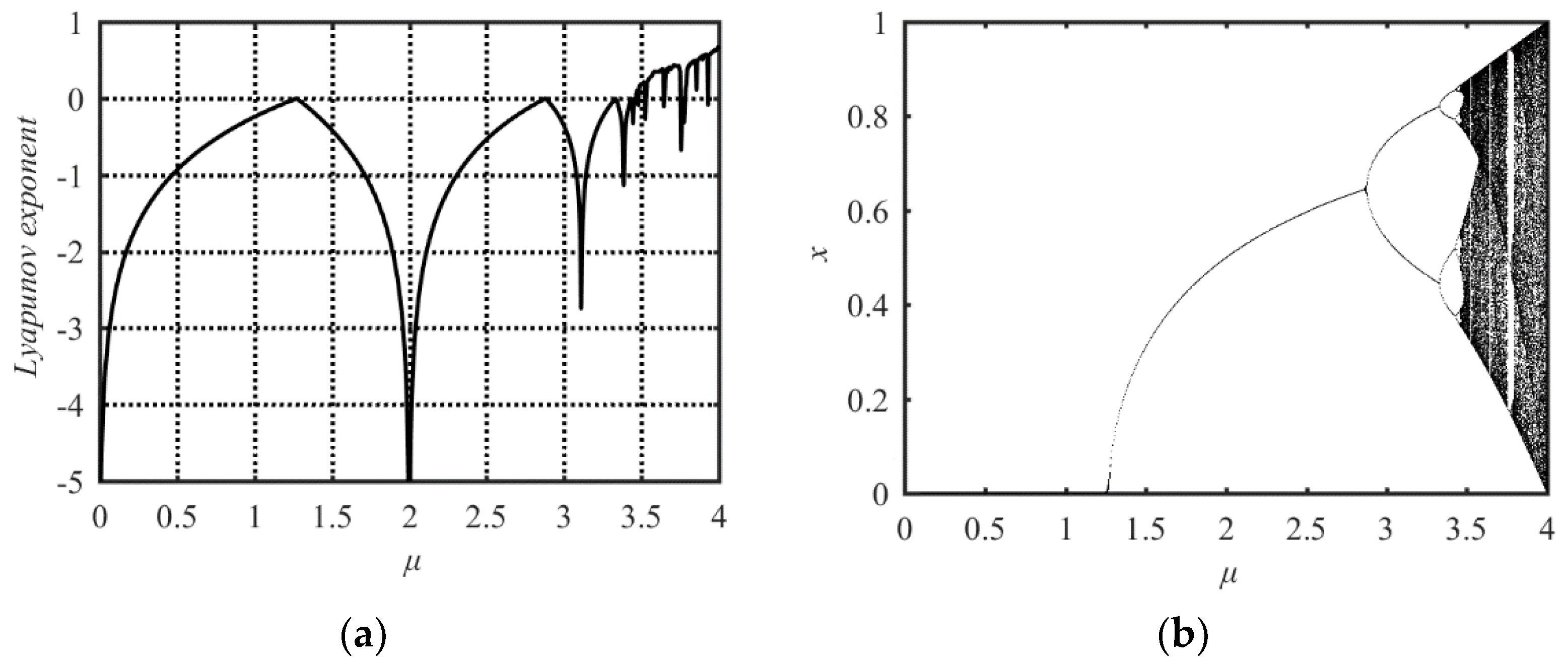

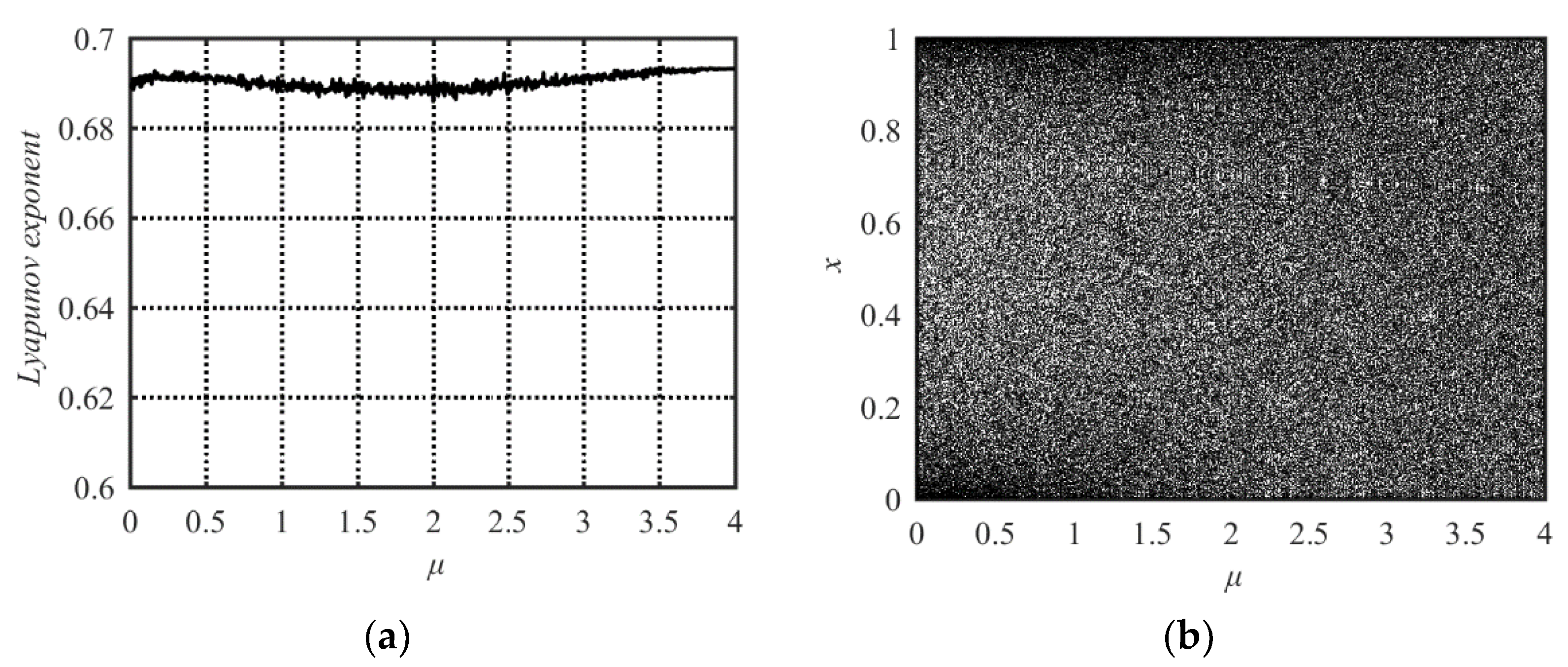
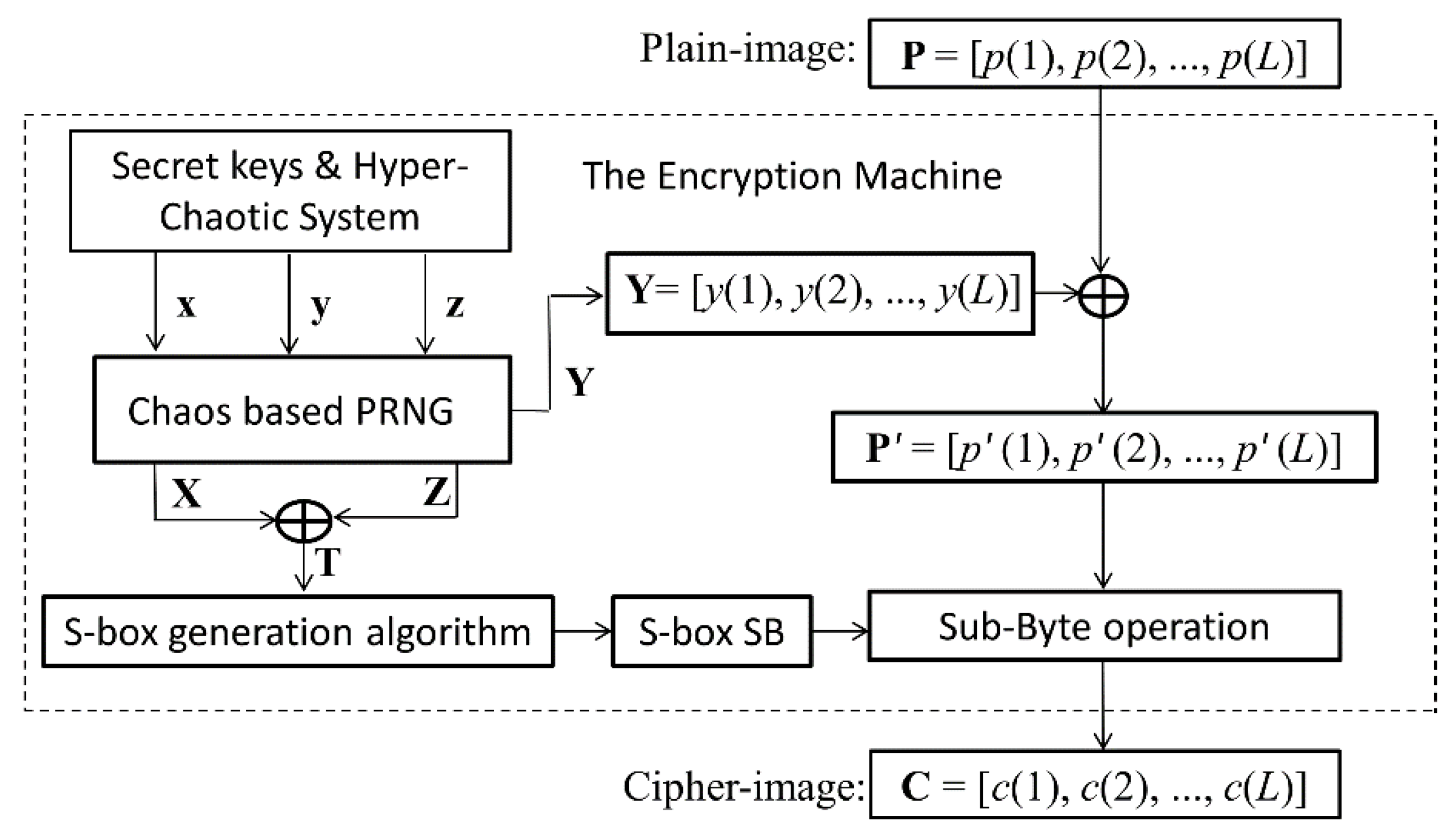


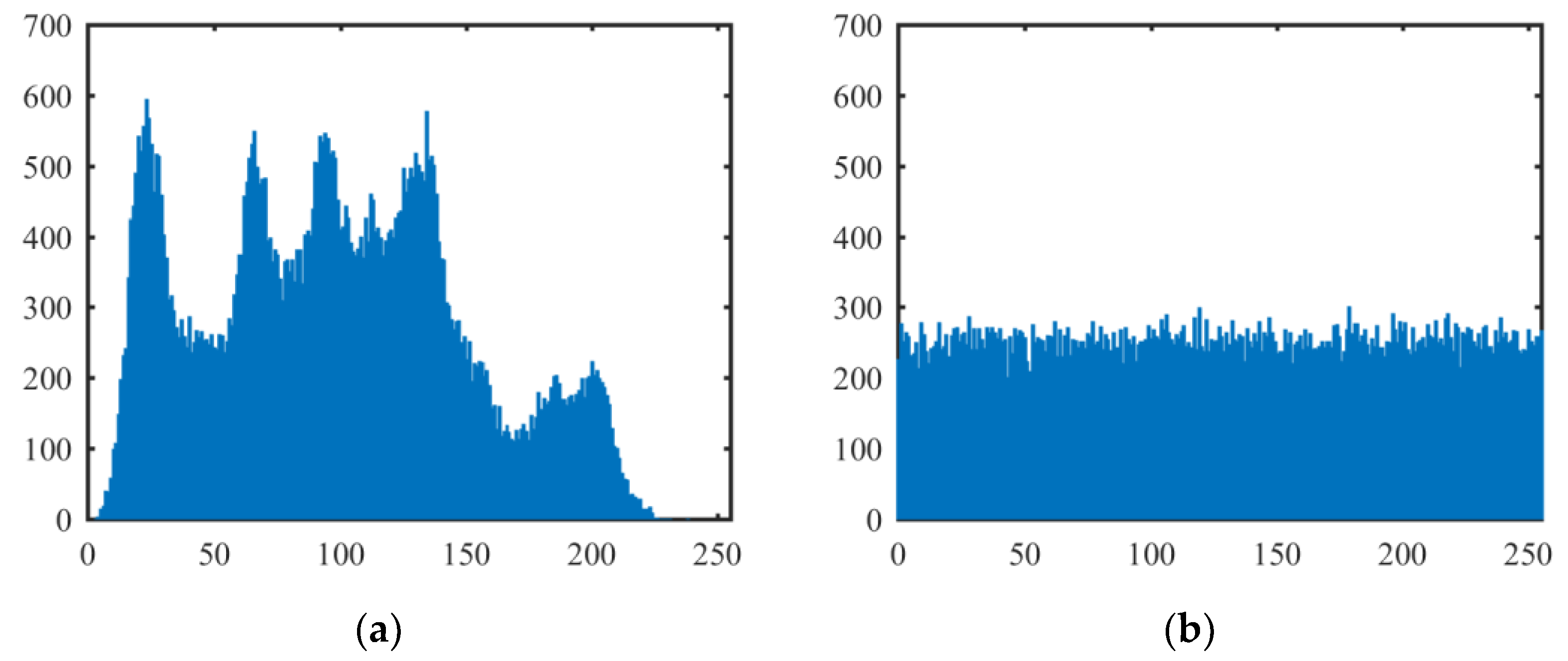
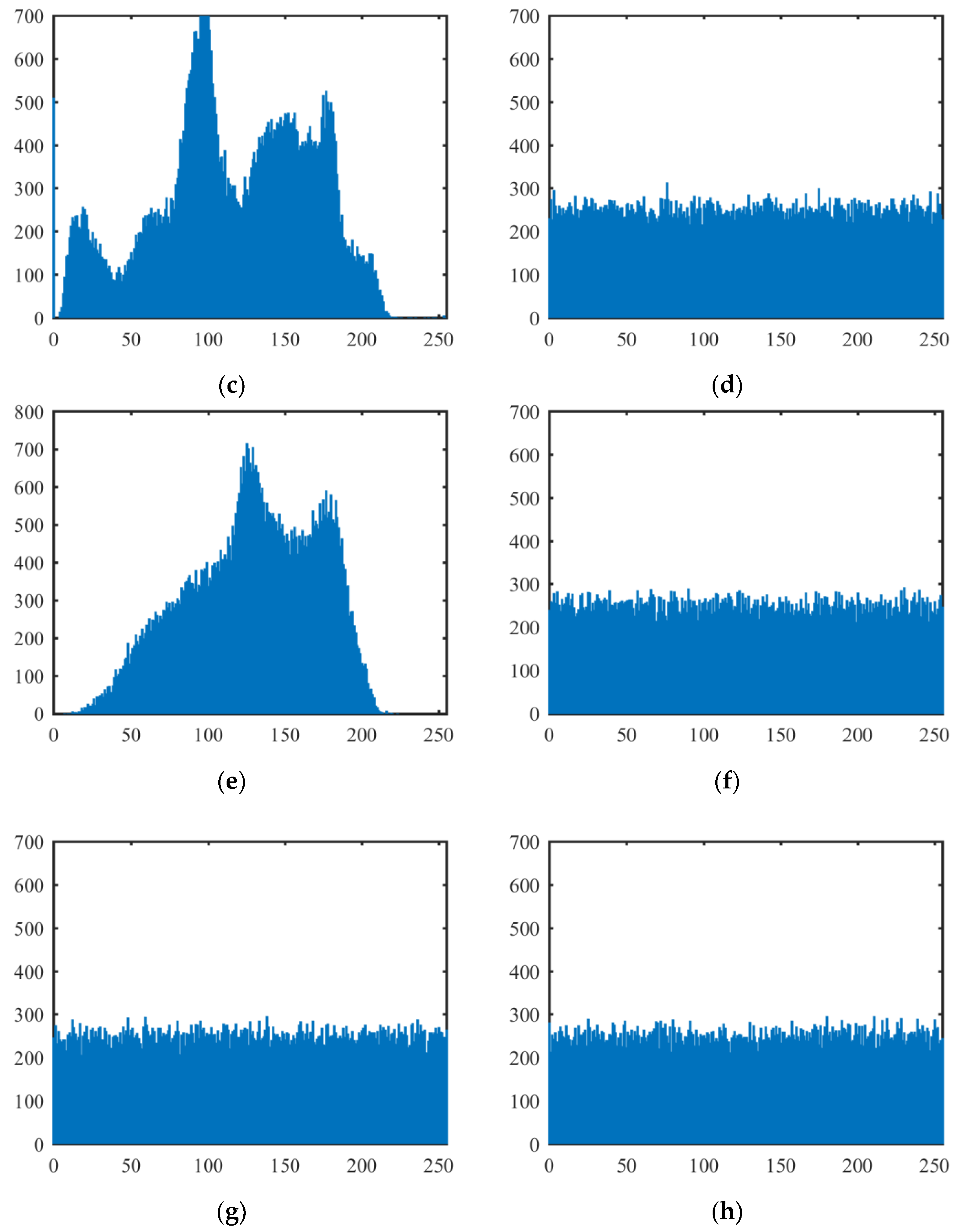
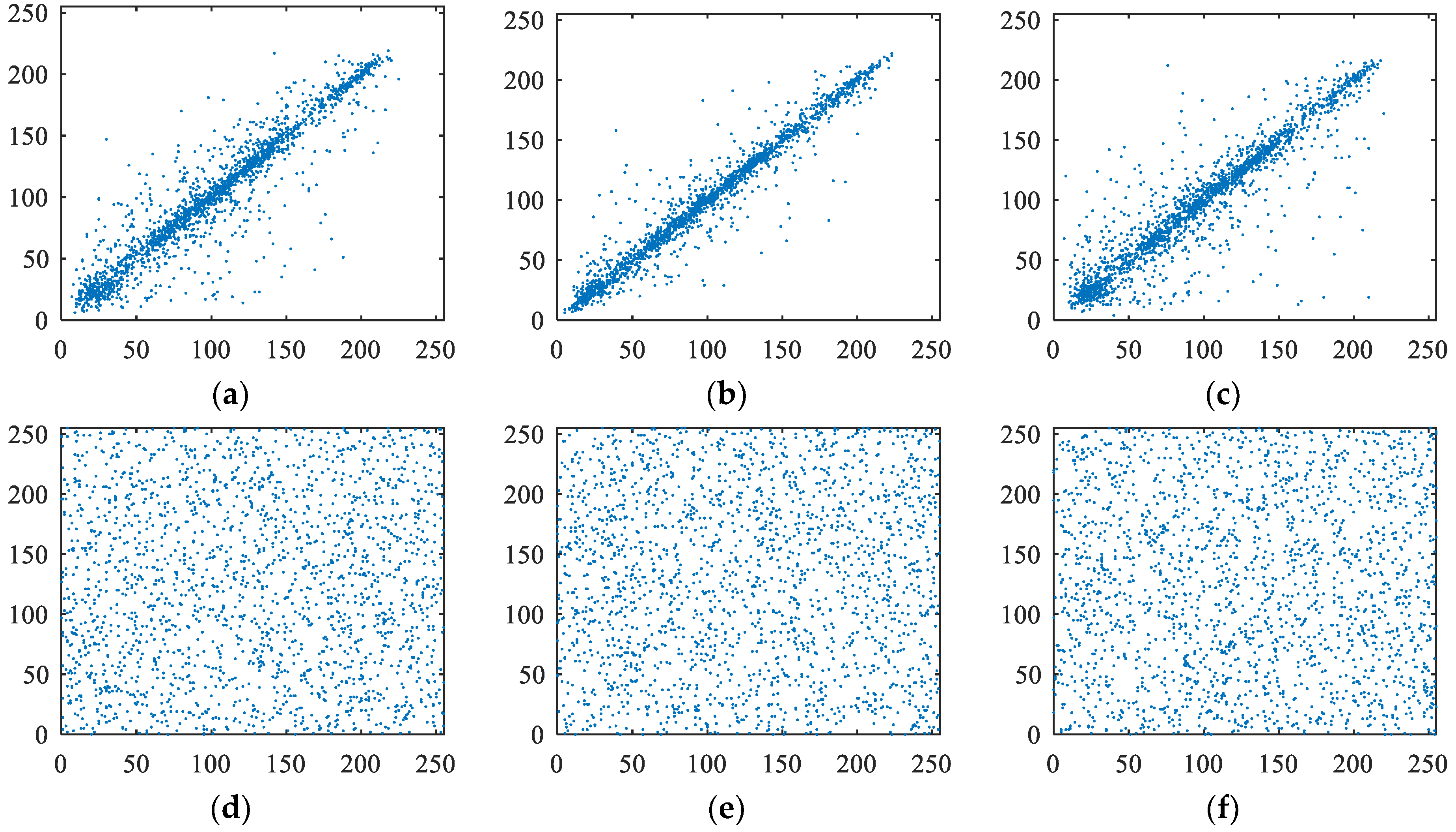
| S-box | c1 | c2 | c3 | c4 | c5 | c6 | c7 | c8 | c9 | c10 | c11 | c12 | c13 | c14 | c15 | c16 |
|---|---|---|---|---|---|---|---|---|---|---|---|---|---|---|---|---|
| r1 | 27 | 4 | 47 | 58 | 146 | 86 | 137 | 215 | 61 | 68 | 129 | 80 | 131 | 214 | 97 | 119 |
| r2 | 168 | 210 | 253 | 91 | 219 | 30 | 112 | 63 | 52 | 188 | 73 | 139 | 55 | 16 | 158 | 204 |
| r3 | 124 | 71 | 21 | 45 | 169 | 32 | 208 | 121 | 198 | 179 | 246 | 8 | 175 | 194 | 35 | 5 |
| r4 | 70 | 3 | 114 | 42 | 205 | 89 | 101 | 159 | 173 | 127 | 75 | 235 | 118 | 243 | 143 | 141 |
| r5 | 147 | 13 | 196 | 163 | 11 | 62 | 134 | 76 | 191 | 133 | 132 | 145 | 33 | 43 | 120 | 31 |
| r6 | 17 | 156 | 245 | 186 | 25 | 237 | 88 | 161 | 0 | 83 | 87 | 72 | 116 | 150 | 255 | 226 |
| r7 | 138 | 74 | 46 | 34 | 136 | 99 | 12 | 218 | 110 | 195 | 105 | 57 | 172 | 65 | 2 | 216 |
| r8 | 211 | 184 | 19 | 20 | 84 | 242 | 85 | 98 | 189 | 22 | 24 | 185 | 166 | 109 | 15 | 217 |
| r9 | 167 | 48 | 56 | 78 | 90 | 59 | 36 | 244 | 6 | 107 | 142 | 180 | 23 | 238 | 106 | 7 |
| r10 | 28 | 247 | 199 | 201 | 40 | 250 | 206 | 183 | 223 | 200 | 29 | 67 | 128 | 126 | 10 | 241 |
| r11 | 113 | 233 | 207 | 140 | 152 | 135 | 122 | 174 | 228 | 151 | 102 | 148 | 79 | 176 | 49 | 95 |
| r12 | 190 | 103 | 92 | 39 | 64 | 1 | 171 | 220 | 212 | 51 | 221 | 130 | 249 | 170 | 164 | 230 |
| r13 | 60 | 162 | 117 | 154 | 157 | 160 | 229 | 187 | 100 | 26 | 37 | 155 | 225 | 222 | 232 | 104 |
| r14 | 181 | 224 | 53 | 18 | 108 | 96 | 66 | 38 | 248 | 182 | 178 | 251 | 165 | 231 | 202 | 81 |
| r15 | 50 | 93 | 149 | 9 | 239 | 192 | 209 | 82 | 115 | 236 | 44 | 144 | 69 | 111 | 153 | 125 |
| r16 | 254 | 41 | 227 | 213 | 193 | 14 | 77 | 197 | 54 | 123 | 203 | 177 | 94 | 252 | 234 | 240 |
| S-box | c1 | c2 | c3 | c4 | c5 | c6 | c7 | c8 | c9 | c10 | c11 | c12 | c13 | c14 | c15 | c16 |
|---|---|---|---|---|---|---|---|---|---|---|---|---|---|---|---|---|
| r1 | 75 | 140 | 59 | 156 | 233 | 234 | 149 | 214 | 126 | 105 | 134 | 228 | 101 | 84 | 111 | 35 |
| r2 | 113 | 241 | 53 | 202 | 17 | 96 | 93 | 168 | 172 | 82 | 78 | 203 | 159 | 182 | 249 | 118 |
| r3 | 115 | 68 | 195 | 107 | 189 | 104 | 165 | 80 | 39 | 94 | 150 | 254 | 199 | 183 | 157 | 74 |
| r4 | 52 | 210 | 55 | 200 | 229 | 48 | 132 | 163 | 219 | 201 | 117 | 146 | 153 | 43 | 71 | 230 |
| r5 | 60 | 70 | 103 | 211 | 95 | 92 | 36 | 12 | 81 | 133 | 46 | 176 | 209 | 251 | 237 | 186 |
| r6 | 98 | 136 | 20 | 44 | 178 | 185 | 177 | 19 | 137 | 50 | 21 | 206 | 65 | 192 | 129 | 79 |
| r7 | 240 | 7 | 121 | 38 | 27 | 196 | 25 | 167 | 89 | 72 | 162 | 221 | 148 | 147 | 24 | 223 |
| r8 | 100 | 47 | 248 | 164 | 34 | 29 | 73 | 69 | 245 | 1 | 10 | 191 | 216 | 26 | 204 | 18 |
| r9 | 37 | 15 | 32 | 108 | 9 | 160 | 139 | 220 | 238 | 232 | 58 | 161 | 109 | 6 | 169 | 62 |
| r10 | 45 | 3 | 0 | 180 | 114 | 120 | 246 | 250 | 33 | 194 | 198 | 13 | 158 | 31 | 66 | 155 |
| r11 | 83 | 125 | 244 | 51 | 212 | 97 | 91 | 99 | 77 | 138 | 173 | 243 | 253 | 102 | 123 | 166 |
| r12 | 225 | 208 | 110 | 40 | 222 | 87 | 218 | 197 | 170 | 184 | 124 | 131 | 4 | 112 | 179 | 255 |
| r13 | 85 | 64 | 193 | 88 | 56 | 16 | 236 | 207 | 181 | 144 | 231 | 239 | 152 | 135 | 122 | 67 |
| r14 | 151 | 171 | 42 | 154 | 142 | 247 | 28 | 41 | 14 | 252 | 224 | 188 | 54 | 175 | 217 | 130 |
| r15 | 22 | 215 | 49 | 5 | 141 | 11 | 2 | 127 | 145 | 86 | 116 | 213 | 205 | 63 | 242 | 128 |
| r16 | 30 | 226 | 227 | 106 | 187 | 23 | 174 | 190 | 143 | 8 | 76 | 61 | 235 | 119 | 57 | 90 |
| NIST-800-22 Tests | p-Value | Result |
|---|---|---|
| Frequency Test | 1.00000 | SUCCESS |
| Block Frequency Test | 0.320250 | SUCCESS |
| Cumulative Sums Test | 0.536610 | SUCCESS |
| Runs Test | 0.894524 | SUCCESS |
| Longest Run of Ones Test | 1.0000 | SUCCESS |
| Rank Test | 0.481248 | SUCCESS |
| Discrete Fourier Transform Test | 0.807748 | SUCCESS |
| Nonperiodic Template Matchings Test | 0.861831 | SUCCESS |
| Overlapping Template Matchings Test | 0.282761 | SUCCESS |
| Approximate Entropy Test | 0.011732 | SUCCESS |
| Serial Test | 0.239176 | SUCCESS |
| Linear Complexity Test | 0.203697 | SUCCESS |
| Random Excursions Test | \ | TESTNOTAPPLICABLE |
| Random Excursions Variant Test | \ | TESTNOTAPPLICABLE |
| Universal Statistical Test | \ | TESTNOTAPPLICABLE |
| Images | Plain Image | Cipher Image | Cipher Image [39] | Cipher Image [40] | Cipher Image [57] |
|---|---|---|---|---|---|
| Lena | 30,665.703 | 221.195 | 284.578 | 283.156 | 381.688 |
| Peppers | 36,379.133 | 224.234 | 269.727 | 227.898 | 332.898 |
| Baboon | 47,799.055 | 288.664 | 268.211 | 277.297 | 297.625 |
| All-white image | 16,711,680 | 293.039 | 544.234 | 41,725.063 | 1214.484 |
| All-black image cipher image | 16,711,680 | 256.430 | 1396.765 | 43,233.188 | 1214.484 |
| Average | 6,707,640.778 | 256.713 | 552.703 | 17,149.320 | 688.236 |
| Algorithms | Horizontal | Vertical | Diagonal |
|---|---|---|---|
| The proposed algorithm | −0.002088 | 0.000312 | 0.001444 |
| Zhang’s algorithm [39] | −0.000582 | 0.001336 | −0.004690 |
| Wang’s algorithm [40] | 0.006057 | 0.012468 | −0.006030 |
| Çavuşoğlu’s algorithm [57] | 0.001640 | 0.031372 | −0.000626 |
| Test Images | Ref. [39] | Ref. [40] | Ref. [57] | Ours |
|---|---|---|---|---|
| Lena cipher image | 7.9969 | 7.9969 | 7.9958 | 7.9976 |
| Peppers cipher image | 7.9970 | 7.9975 | 7.9963 | 7.9975 |
| Baboon cipher image | 7.9970 | 7.9969 | 7.9967 | 7.9968 |
| All-black cipher image | 7.9846 | 7.3901 | 7.9871 | 7.9972 |
| All-white cipher image | 7.9940 | 7.3998 | 7.9871 | 7.9968 |
| Position i | Values | Zhang’s [39] | Wang’s [40] | Çavuşoğlu’s [57] | Ours |
|---|---|---|---|---|---|
| 1 | NPCR(%) | 49.81 | 1.53 × 10−3 | 1.53 × 10−3 | 99.64 |
| 1 | UACI(%) | 16.86 | 1.14 × 10−3 | 2.75 × 10−4 | 33.55 |
| L/4 | NPCR(%) | 74.69 | 1.53 × 10−3 | 1.53 × 10−3 | 99.59 |
| L/4 | UACI(%) | 25.08 | 1.68 × 10−4 | 8.26 × 10−4 | 33.25 |
| L/2 | NPCR(%) | 99.64 | 1.53 × 10−3 | 1.53 × 10−3 | 99.57 |
| L/2 | UACI(%) | 33.54 | 6.10 × 10−4 | 4.13 × 10−4 | 33.41 |
| L | NPCR(%) | 49.84 | 1.53 × 10−3 | 1.53 × 10−3 | 99.62 |
| L | UACI(%) | 16.72 | 8.80 × 10−4 | 8.62 × 10−4 | 33.46 |
| Values | ∆x10 = 10−15 | ∆μ1 = 10−15 | ∆x20 = 10−15 | ∆μ2 = 10−15 | ∆d1 = 1 | ∆d2 = 1 | ∆r0 = 1 | ∆t0 = 1 | ∆m = 1 |
|---|---|---|---|---|---|---|---|---|---|
| NPCR(%) | 99.63 | 99.62 | 99.56 | 99.62 | 99.61 | 99.58 | 99.63 | 99.61 | 99.61 |
| UACI(%) | 33.53 | 33.34 | 33.50 | 33.41 | 33.38 | 33.53 | 33.46 | 33.41 | 33.37 |
© 2019 by the authors. Licensee MDPI, Basel, Switzerland. This article is an open access article distributed under the terms and conditions of the Creative Commons Attribution (CC BY) license (http://creativecommons.org/licenses/by/4.0/).
Share and Cite
Zhu, S.; Wang, G.; Zhu, C. A Secure and Fast Image Encryption Scheme Based on Double Chaotic S-Boxes. Entropy 2019, 21, 790. https://doi.org/10.3390/e21080790
Zhu S, Wang G, Zhu C. A Secure and Fast Image Encryption Scheme Based on Double Chaotic S-Boxes. Entropy. 2019; 21(8):790. https://doi.org/10.3390/e21080790
Chicago/Turabian StyleZhu, Shenli, Guojun Wang, and Congxu Zhu. 2019. "A Secure and Fast Image Encryption Scheme Based on Double Chaotic S-Boxes" Entropy 21, no. 8: 790. https://doi.org/10.3390/e21080790
APA StyleZhu, S., Wang, G., & Zhu, C. (2019). A Secure and Fast Image Encryption Scheme Based on Double Chaotic S-Boxes. Entropy, 21(8), 790. https://doi.org/10.3390/e21080790







